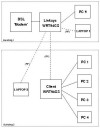I have a D-Link wireless router (In Basement), a wireless nic in the PC (My room). Internet works fine. Then I tried to set up a LAN with my Wired D-Link router (In my Room) to connect my two PC's together. Nothing works! When I enable my LAN connection my internet goes down! When I disable the LAN connection the internet comes back! It's like the LAN connection takes over when it’s enabled. I want to have internet access as well as have my own little LAN. Can someone help?
Thanks!
Sorry, I have Windows XP Pro

